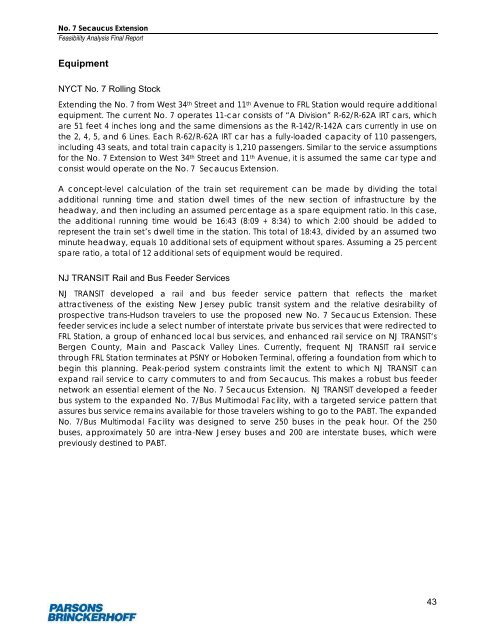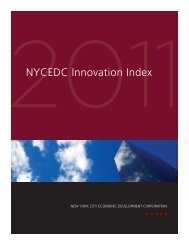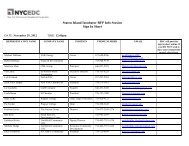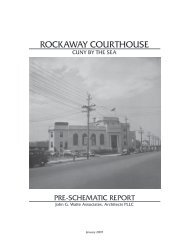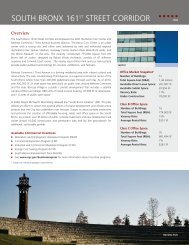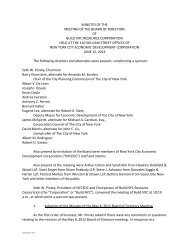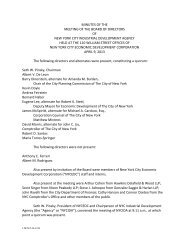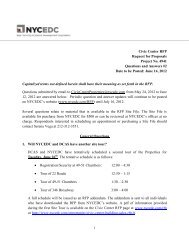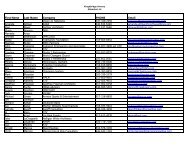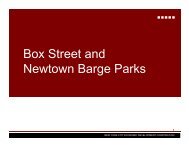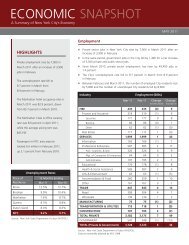No 7 Secaucus Extension Final Report - NYCEDC
No 7 Secaucus Extension Final Report - NYCEDC
No 7 Secaucus Extension Final Report - NYCEDC
You also want an ePaper? Increase the reach of your titles
YUMPU automatically turns print PDFs into web optimized ePapers that Google loves.
<strong>No</strong>. 7 <strong>Secaucus</strong> <strong>Extension</strong>Feasibility Analysis <strong>Final</strong> <strong>Report</strong>EquipmentNYCT <strong>No</strong>. 7 Rolling StockExtending the <strong>No</strong>. 7 from West 34 th Street and 11 th Avenue to FRL Station would require additionalequipment. The current <strong>No</strong>. 7 operates 11-car consists of “A Division” R-62/R-62A IRT cars, whichare 51 feet 4 inches long and the same dimensions as the R-142/R-142A cars currently in use onthe 2, 4, 5, and 6 Lines. Each R-62/R-62A IRT car has a fully-loaded capacity of 110 passengers,including 43 seats, and total train capacity is 1,210 passengers. Similar to the service assumptionsfor the <strong>No</strong>. 7 <strong>Extension</strong> to West 34 th Street and 11 th Avenue, it is assumed the same car type andconsist would operate on the <strong>No</strong>. 7 <strong>Secaucus</strong> <strong>Extension</strong>.A concept-level calculation of the train set requirement can be made by dividing the totaladditional running time and station dwell times of the new section of infrastructure by theheadway, and then including an assumed percentage as a spare equipment ratio. In this case,the additional running time would be 16:43 (8:09 + 8:34) to which 2:00 should be added torepresent the train set’s dwell time in the station. This total of 18:43, divided by an assumed twominute headway, equals 10 additional sets of equipment without spares. Assuming a 25 percentspare ratio, a total of 12 additional sets of equipment would be required.NJ TRANSIT Rail and Bus Feeder ServicesNJ TRANSIT developed a rail and bus feeder service pattern that reflects the marketattractiveness of the existing New Jersey public transit system and the relative desirability ofprospective trans-Hudson travelers to use the proposed new <strong>No</strong>. 7 <strong>Secaucus</strong> <strong>Extension</strong>. Thesefeeder services include a select number of interstate private bus services that were redirected toFRL Station, a group of enhanced local bus services, and enhanced rail service on NJ TRANSIT‘sBergen County, Main and Pascack Valley Lines. Currently, frequent NJ TRANSIT rail servicethrough FRL Station terminates at PSNY or Hoboken Terminal, offering a foundation from which tobegin this planning. Peak-period system constraints limit the extent to which NJ TRANSIT canexpand rail service to carry commuters to and from <strong>Secaucus</strong>. This makes a robust bus feedernetwork an essential element of the <strong>No</strong>. 7 <strong>Secaucus</strong> <strong>Extension</strong>. NJ TRANSIT developed a feederbus system to the expanded <strong>No</strong>. 7/Bus Multimodal Facility, with a targeted service pattern thatassures bus service remains available for those travelers wishing to go to the PABT. The expanded<strong>No</strong>. 7/Bus Multimodal Facility was designed to serve 250 buses in the peak hour. Of the 250buses, approximately 50 are intra-New Jersey buses and 200 are interstate buses, which werepreviously destined to PABT.43


